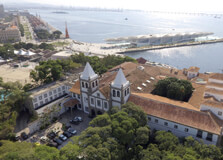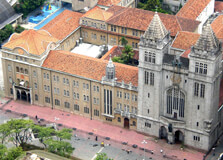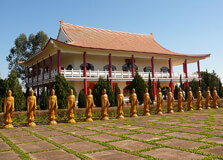
- Home
- Travel Packages
- Top Destination
-
Travel Attraction
By Category
Top Attraction

- Travel Agents
- Car Rentals
- Hotels

The Sao Bento Monastery, located in Rio de Janeiro, Brazil, was founded in 1590 by Benedictine monks. The monastery has a rich history dating back over 400 years, with the current building completed in the early 17th century. It has served as a place of worship, education, and community for generations, making it an important cultural and religious landmark in the city. Architecture and Design The Sao Bento Monastery is known for its stunning Baroque architecture, characterized by intricate details, ornate decorations, and grandeur. The monastery features a beautiful church with gold-leafed altars, frescoes, and sculptures, showcasing the craftsmanship of the period. The design of the monastery reflects the dedication of the Benedictine monks to creating a sacred space that inspires awe and reverence. Best Time to Visit The best time to visit the Sao Bento Monastery is during the early morning or late afternoon when the light is ideal for capturing the beauty of the architecture and design. Weekdays are generally less crowded than weekends, providing a more peaceful and contemplative experience for visitors. Additionally, visiting during special religious festivals or events can offer a unique insight into the cultural traditions of the monastery. Cultural Significance The Sao Bento Monastery holds significant cultural importance in Rio de Janeiro, as it is a symbol of faith, tradition, and history. The monastery's religious services, music performances, and art exhibitions showcase the vibrant cultural heritage of Brazil and the enduring influence of Catholicism on the country's identity. Visitors can immerse themselves in the rich tapestry of Brazilian culture by exploring the Sao Bento Monastery and learning about its role in shaping the community. Pilgrimage Practices Pilgrims often visit the Sao Bento Monastery to seek spiritual guidance, offer prayers, and participate in religious rituals. They may attend mass, light candles, or participate in processions to honor saints or religious figures. The monastery's serene atmosphere and sacred surroundings provide a peaceful setting for pilgrims to reflect, meditate, and connect with their faith. Pilgrimage practices at the Sao Bento Monastery offer individuals a meaningful and transformative experience that can deepen their spiritual journey. Dress Code and Etiquette Visitors to the Sao Bento Monastery are expected to dress modestly and respectfully in keeping with the sacred nature of the site. Both men and women should cover their shoulders and knees, and avoid wearing revealing or inappropriate clothing. It is also important to speak in hushed tones and refrain from using electronic devices or taking photographs in restricted areas. By adhering to the dress code and etiquette guidelines, visitors can show their respect for the monastery and its religious traditions. Activities and Experiences Visitors to the Sao Bento Monastery can participate in a variety of activities and experiences that offer a deeper understanding of the site's history and significance. Guided tours of the monastery provide insights into its architecture, art, and religious practices, while attending a church service offers a glimpse into the spiritual life of the Benedictine monks. Special events, such as musical performances or cultural festivals, showcase the vibrant culture of Rio de Janeiro and celebrate the monastery's legacy in the community. Art and Religious Symbols The Sao Bento Monastery is adorned with a wealth of art and religious symbols that reflect the spiritual beliefs and practices of the Benedictine order. Intricate carvings, paintings, and sculptures depict scenes from the Bible, saints, and religious figures, conveying the monastery's devotion to faith and worship. Symbols such as crosses, angels, and sacred geometry are incorporated into the architecture and design of the monastery, serving as reminders of the divine presence that permeates the space. Local Insights Local residents of Rio de Janeiro view the Sao Bento Monastery as a cherished landmark that holds a special place in the city's history and culture. Many locals have fond memories of attending religious services, concerts, or community events at the monastery, and value its role as a spiritual and social hub in the neighborhood. Residents often recommend visiting the Sao Bento Monastery to tourists as a way to experience the authentic spirit of Rio de Janeiro and connect with the city's rich cultural heritage.
Explore More
The Mosteiro De Sao Bento, located in Sao Paulo, Brazil, has a rich history dating back to 1598 when it was founded by monks from the Order of Saint Benedict. The monastery has played a significant role in the city's religious and cultural heritage, serving as a place of worship, contemplation, and education for centuries. Architecture and Design The Mosteiro De Sao Bento is known for its stunning Baroque architecture, characterized by intricate detailing, ornate decorations, and grandiose facades. The monastery's design features a harmonious blend of European and Brazilian influences, with beautiful frescoes, altarpieces, and sculptures adorning the interior. The cloisters, chapels, and gardens showcase the skilled craftsmanship of the architects and artisans who worked on the building. Best Time to Visit The best time to visit Mosteiro De Sao Bento is during the early morning or late afternoon when the sunlight enhances the beauty of the architectural details and creates a serene atmosphere for contemplation and prayer. Avoid visiting during peak hours to experience the monastery's tranquility and spiritual ambiance fully. Cultural Significance The Mosteiro De Sao Bento holds a significant cultural importance in Sao Paulo, serving as a symbol of faith, tradition, and history for the local community. The monastery's religious ceremonies, musical performances, and art exhibitions contribute to the city's cultural heritage and attract visitors from around the world. Pilgrimage Practices Many pilgrims visit the Mosteiro De Sao Bento to seek spiritual solace, participate in religious services, and pay homage to the patron saint of the monastery. Pilgrimage practices include attending Mass, lighting candles, praying at sacred shrines, and receiving blessings from the monks. The monastery provides a sacred space for pilgrims to deepen their faith and connect with the divine. Dress Code and Etiquette Visitors to the Mosteiro De Sao Bento are expected to dress modestly and respectfully when entering the monastery. Proper attire includes covering shoulders, wearing long pants or skirts, and avoiding revealing clothing. Silence and reverence are also essential etiquette practices to observe while inside the monastery, as a sign of respect for the monks and their religious practices. Activities and Experiences Guests at the Mosteiro De Sao Bento can participate in a variety of activities and experiences, including guided tours, spiritual retreats, choir performances, and workshops on Benedictine spirituality. Visitors can also explore the monastery's art collection, attend religious services, meditate in the gardens, and purchase religious souvenirs from the gift shop. The monastery offers a range of opportunities for personal growth, cultural enrichment, and spiritual renewal. Art and Religious Symbols The Mosteiro De Sao Bento is adorned with exquisite art and religious symbols that reflect the monastery's devotion to the Catholic faith and its commitment to artistic excellence. The interior features intricate carvings, gilded altars, stained glass windows, and sacred statues that depict biblical scenes and saints. Symbolic motifs such as crosses, doves, and lilies are prevalent throughout the monastery, serving as reminders of the monks' dedication to God and their mission of spreading the Gospel. Local Insights For a deeper appreciation of the Mosteiro De Sao Bento, visitors can engage with the local community, attend cultural events, and explore nearby attractions in Sao Paulo. Local insights include learning about the monastery's history from knowledgeable guides, participating in traditional rituals and festivals, and savoring Brazilian cuisine at local restaurants. By immersing themselves in the city's vibrant culture and connecting with its residents, visitors can gain a deeper understanding of the Mosteiro De Sao Bento and its significance in the fabric of Sao Paulo's heritage.
Explore More
The Templo Budista, or Buddhist Temple, in Foz do Iguaçu is a peaceful and spiritual destination that offers visitors a different perspective from the adventurous experiences typically associated with Iguassu Falls. Located on a hill with a panoramic view of the city and the Paraná River, this serene site features beautifully crafted statues, traditional Buddhist architecture, and lush gardens that invite reflection and tranquility. Built and maintained by the Chinese Buddhist community in the region, the temple is a symbol of cultural diversity in Foz do Iguaçu, which is also home to large populations of Christians, Muslims, and others. The Templo Budista provides a space for meditation and learning about Buddhist teachings while offering a scenic spot for tourists and locals alike. How to Reach Templo Budista, Iguassu Falls Templo Budista is located in the Porto Belo neighborhood of Foz do Iguaçu, approximately 6 km from the city center and about 15 km from the entrance to Iguaçu National Park. The easiest way to reach the temple is by taxi, ride-sharing services, or private car. From the city center, the drive takes around 10 to 15 minutes. Public buses also serve the area; you can take a bus bound for "Jardim das Flores" or "Porto Belo" and get off near the temple. Many city tours also include the Buddhist Temple as part of their itinerary. Weather at Templo Budista, Iguassu Falls Foz do Iguaçu has a subtropical climate, with warm, humid summers and mild winters. Summer temperatures (December to March) can exceed 35°C (95°F), while winters (June to August) range between 12°C to 24°C (54°F to 75°F). Rain is possible year-round, though heaviest between November and March. Since the temple grounds are mostly outdoors, it’s advisable to visit on a dry day and wear light, comfortable clothing. A hat, sunscreen, and water bottle are also recommended for sunny days. Timings of Templo Budista The Templo Budista is open to the public from Tuesday to Sunday, between 9:30 AM and 4:30 PM. It is closed on Mondays and some national holidays. Entry is allowed until about 4:00 PM to give visitors enough time to explore the area. The site can be visited year-round, and mornings or late afternoons are best for avoiding the mid-day heat and crowds. Why Famous for Templo Budista, Iguassu Falls? The Templo Budista is famous for its peaceful atmosphere and striking collection of Buddhist statues. The most iconic feature is a 7-meter-tall statue of Buddha sitting in meditation, facing the city. Surrounding it are over 120 smaller statues of Buddha in various poses, creating an impressive and serene landscape. It is also known for its beautiful views of Foz do Iguaçu and Ciudad del Este (Paraguay), offering one of the best panoramic spots in the region. The temple is a cultural and spiritual symbol, attracting visitors interested in religion, architecture, and photography. Entry and Visit Details about Templo Budista, Iguassu Falls Entry to the Templo Budista is free of charge, making it an accessible option for all tourists. There is no need for advance booking. Visitors are expected to maintain respectful behavior on the grounds, as it is an active religious site. While the main temple building is not always open to the public, the outdoor area with statues and gardens is always accessible during operating hours. Modest clothing is recommended, and silence is appreciated to maintain the spiritual ambiance of the site. History and Architecture The Templo Budista was inaugurated in 1996 by the Chen Tien Buddhist community, composed largely of Chinese immigrants and descendants living in the region. It was built to serve both religious purposes and as a cultural center to promote Buddhist values of peace, compassion, and harmony. Architecturally, the temple is influenced by traditional Chinese Buddhist styles. The main structure features curved rooflines, symbolic carvings, and bright colors. The surrounding gardens are meticulously maintained and feature bonsai trees, flowering plants, and carefully laid paths. The statues were imported from Asia and symbolize different teachings and aspects of Buddha's life. Things to Do at Templo Budista While the site is not large, it offers a range of relaxing and enriching activities: Admire the Buddha Statues: Walk among the dozens of statues representing different poses and meanings. Photography: Capture scenic views of the statues, temple architecture, and panoramic landscapes. Meditation and Reflection: Use the peaceful setting to relax your mind or practice meditation. Learn about Buddhism: Information panels and occasional temple guides provide insight into Buddhist beliefs and the history of the site. Enjoy the Gardens: Take a quiet walk through beautifully maintained gardens filled with local and exotic plants. Facts and Tips about Templo Budista, Iguassu Falls The temple is situated on a hill, offering spectacular views of the border between Brazil and Paraguay. There are over 120 statues on site, including a massive seated Buddha and guardian warrior figures. Photography is allowed, but drones may be restricted to protect the peaceful environment. It’s a great place for families, couples, and solo travelers seeking a calm atmosphere. There is a small shop that sells Buddhist souvenirs, books, and incense. Respectful attire and behavior are expected. Loud noise and smoking are not allowed. It is an ideal location for watching sunsets over the Paraná River and taking in panoramic views. It’s one of the few Buddhist temples in southern Brazil, making it culturally unique. The site has basic facilities like restrooms and shaded seating areas. The Templo Budista in Iguassu Falls is a peaceful retreat that offers beauty, culture, and spiritual insight. Whether you're interested in religion, architecture, or simply seeking a quiet spot with breathtaking views, this temple provides a unique experience in Foz do Iguaçu. A visit here adds cultural depth to your trip and allows you to pause and reflect in one of Brazil’s most serene locations.
Explore More